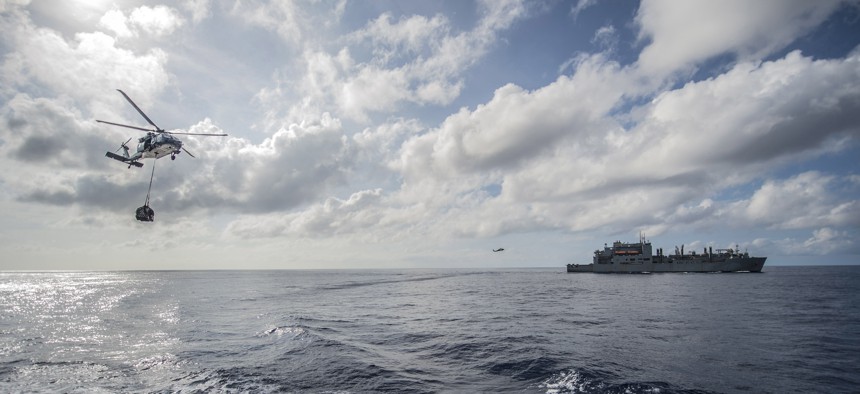
Military Sealift Command fleet replenishment oiler USNS John Ericsson (T-AO 194) and MH-60S Seahawk helicopters from the Island Knights of Helicopter Sea Combat Squadron (HSC) 25 participate in an exercise in the South China Sea, Oct. 20, 2014. U.S. Navy photo by Mass Communication Specialist Seaman Alonzo M. Archer
China Is No Reason to Abandon the INF
Putting U.S. ground-launched intermediate-range missiles in the Pacific would be tactically ineffective and strategically destabilizing.
A green speck within the vast blue of the western Pacific, the tiny island of Guam has long played an outsized role in the geopolitics of the world’s largest ocean. But if the Intermediate-Range Nuclear Forces, or INF, Treaty is tossed aside, Guam’s strategic importance may soon be on the rise—for all the wrong reasons.
Donald Trump’s announcement that he planned to “terminate the agreement” has left supporters of the decades-old treaty reeling. But others say the move is long overdue, and not just because of Moscow. “China poses a much larger and more sophisticated long-term military threat than Russia,” says Elbridge Colby, director of the defense program at the Center for a New American Security. “Washington would benefit from having the ability to deploy survivable land-based ballistic and cruise missile systems.”
Colby and others cite China’s growing missile arsenal, most of which is conventional and falls within ranges covered by the INF Treaty. “The fact that Beijing has such missiles,” writes Marc Thiessen, a fellow at the American Enterprise Institute, “puts the United States at a strategic disadvantage in any conflict with Beijing…our only possible response would be to strike China with intercontinental ballistic missiles—an unacceptable escalation.”
Their solution: toss out the INF Treaty, develop an American arsenal of ground-launched intermediate-range missiles, and deploy them to allied territory in the western Pacific. This highly visible and survivable strike option would deter China, they argue, or provide the needed flexibility to hit targets in mainland China should conflict erupt (most likely over Taiwan).
Except this logic is wrong, and pursuing it would produce greater strategic instability in exchange for little to no benefit to the United States.
First, virtually no allies would be willing to host new American ground-based missiles aimed at China. Japan has come out in defense of the INF Treaty, calling a U.S. withdrawal “undesirable,” while Australian officials have indicated they have low thresholds for U.S. actions they perceive as needlessly provoking Beijing. Moreover, neither country is likely to view Taiwan as a core security interest in the same way as Washington. The same goes for the Philippines and South Korea, especially during the latter’s delicate diplomatic dance with North Korea, which would certainly view any missile deployment with alarm.
This leaves the tiny island of Guam—nearly 2,000 miles from China—as the only realistic base for ground-launched missiles, an option which poses severe challenges for both survivability and military utility. A 2012 RAND report estimated that in order to target the 40 Chinese airbases likely to be involved in a conflict over Taiwan, the U.S. would need about 600 intermediate-range conventional missiles. It’s hard to imagine hinging survivability on simple dispersal on a land mass one-fifth the size of Rhode Island, yet hardened silos for such a vast force could cost tens of billions of dollars.
Either way, Guam is already a high-value target for Beijing, and any new missile deployment would only raise the incentives strike the island quickly in a fight.
Moreover, it’s not completely obvious what this new force would do. Though missiles stationed on Guam could easily hit stationary objects like military bases, the island’s distance from the mainland would hamper targeting of mobile assets, such as the transporter erector launchers (TELs) that carry the bulk of China’s missile forces. These targets would quickly scatter in wartime, forcing any intermediate-range missile to make constant adjustments on its long journey from Guam—no easy task given that Beijing would likely try to blind American satellites.
Fortunately, a practical solution exists, one that doesn’t involve stationing INF Treaty-busting missiles on Guam. It’s what we’re doing now. Speaking before Congress last year, Gen. Paul Selva, Vice Chairman of the Joint Chiefs of Staff, testified that the argument that the INF Treaty unfairly restricted U.S. capabilities was “a bridge too far,” and that current “deployment of missile systems on aircraft and ships would allow us to hold those [Chinese] targets at risk.
Simply put, there’s no need for ground-based, intermediate-range missiles when we have those aplenty in the air and at sea, all of which would be able to get in closer to China before launching. Yes, ships and aircraft could be sunk or shot down, but you’d have to find them first, and it’s certainly easier to hide a ship in the sheer vastness of the Pacific than it is to hide a missile on the limited confines of Guam.
Whether or not the Trump administration realizes this remains to be seen. But unless they do, the island of Guam may soon turn from green to gray.



